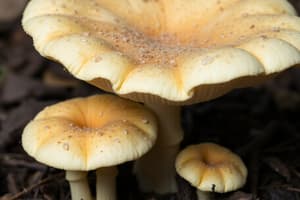Podcast
Questions and Answers
What is the diagnostic character of the phylum Basidiomycota?
What is the diagnostic character of the phylum Basidiomycota?
- Production of endogenous ascospores
- Production of ballistospores
- Presence of a basidium bearing basidiospores (correct)
- Presence of gelatinous films
How are basidiospores dispersed in Basidiomycota?
How are basidiospores dispersed in Basidiomycota?
- By insect pollination
- By animal consumption
- By air currents (correct)
- By water currents
What is the difference between basidiospores in Basidiomycota and ascospores in Ascomycota?
What is the difference between basidiospores in Basidiomycota and ascospores in Ascomycota?
- Basidiospores are produced exogenously, while ascospores are produced endogenously (correct)
- Basidiospores are larger than ascospores
- Basidiospores are produced in gelatinous films, while ascospores are not
- Basidiospores are unicellular, while ascospores are multicellular
What is the approximate number of species in the phylum Basidiomycota?
What is the approximate number of species in the phylum Basidiomycota?
What are the cells called that bear the basidiospores in Basidiomycota?
What are the cells called that bear the basidiospores in Basidiomycota?
Flashcards are hidden until you start studying
Study Notes
Diagnostic Character of Basidiomycota
- Characterized by producing basidiospores on basidia, a specialized reproductive structure.
- Typically contains clamp connections, aiding in dikaryotic cell formation during sexual reproduction.
- Includes various forms, such as mushrooms, puffballs, and shelf fungi, illustrating diverse morphologies.
Dispersal of Basidiospores
- Basidiospores are primarily dispersed by wind, relying on air currents to spread over distances.
- Some species utilize water for dispersal, with spores released during rainfall.
- Dispersal strategies can include the use of animal vectors, although less common.
Difference Between Basidiospores and Ascospores
- Basidiospores are formed on basidia and typically released in groups, while ascospores are formed inside asci of Ascomycota.
- Basidiospores are usually produced via external processes, contrasting with the internal production of ascospores.
- Morphologically, basidiospores are often more varied in shape compared to the usually uniform ascospores.
Approximate Number of Species
- The phylum Basidiomycota comprises around 30,000 species.
- This number includes a wide range of fungi, indicating significant diversity within the group.
Cells Bearing Basidiospores
- The cells that produce and bear basidiospores are called basidia.
- Each basidium typically produces four basidiospores, which are crucial for sexual reproduction in Basidiomycota.
Studying That Suits You
Use AI to generate personalized quizzes and flashcards to suit your learning preferences.




